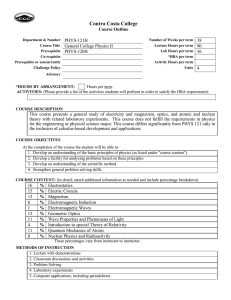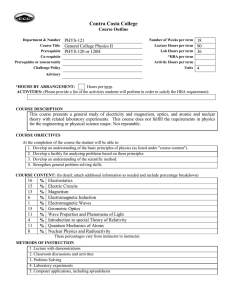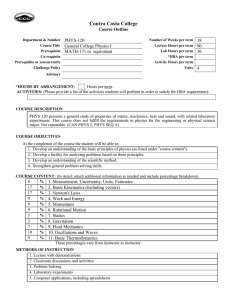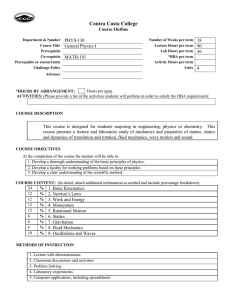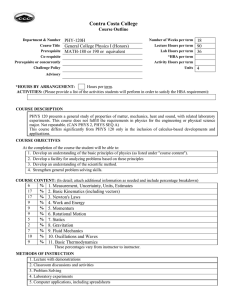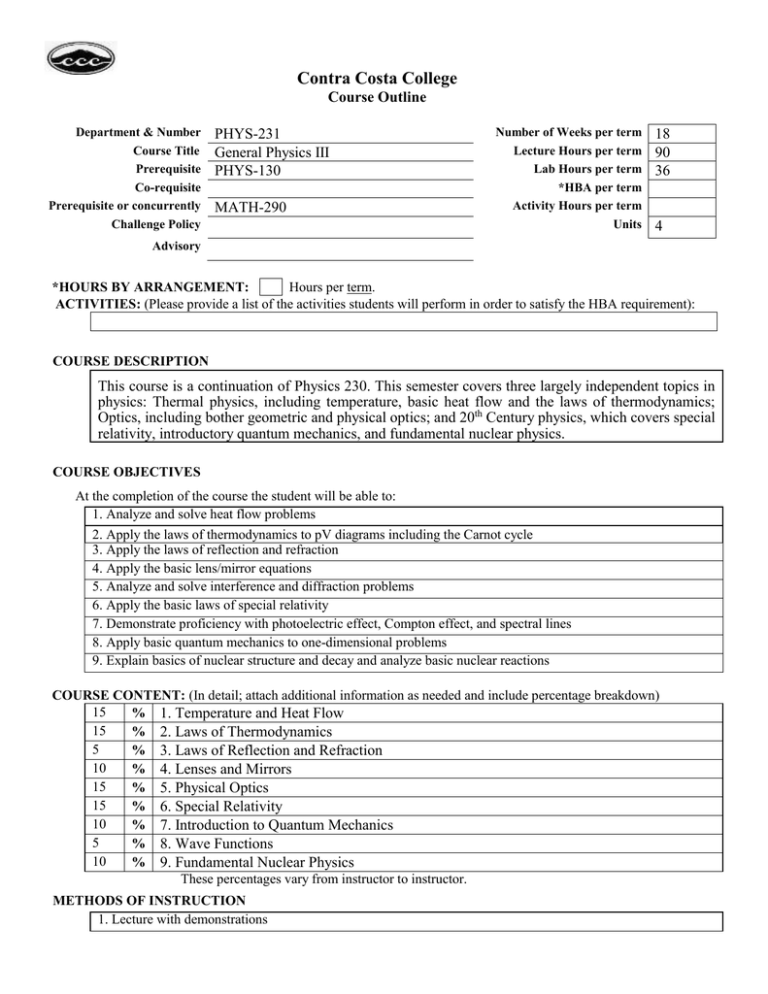
Contra Costa College
Course Outline
Department & Number
Course Title
Prerequisite
Co-requisite
Prerequisite or concurrently
Challenge Policy
PHYS-231
General Physics III
PHYS-130
MATH-290
Number of Weeks per term
Lecture Hours per term
Lab Hours per term
*HBA per term
Activity Hours per term
Units
18
90
36
4
Advisory
Hours per term.
*HOURS BY ARRANGEMENT:
ACTIVITIES: (Please provide a list of the activities students will perform in order to satisfy the HBA requirement):
COURSE DESCRIPTION
This course is a continuation of Physics 230. This semester covers three largely independent topics in
physics: Thermal physics, including temperature, basic heat flow and the laws of thermodynamics;
Optics, including bother geometric and physical optics; and 20th Century physics, which covers special
relativity, introductory quantum mechanics, and fundamental nuclear physics.
COURSE OBJECTIVES
At the completion of the course the student will be able to:
1. Analyze and solve heat flow problems
2. Apply the laws of thermodynamics to pV diagrams including the Carnot cycle
3. Apply the laws of reflection and refraction
4. Apply the basic lens/mirror equations
5. Analyze and solve interference and diffraction problems
6. Apply the basic laws of special relativity
7. Demonstrate proficiency with photoelectric effect, Compton effect, and spectral lines
8. Apply basic quantum mechanics to one-dimensional problems
9. Explain basics of nuclear structure and decay and analyze basic nuclear reactions
COURSE CONTENT: (In detail; attach additional information as needed and include percentage breakdown)
15
% 1. Temperature and Heat Flow
15
% 2. Laws of Thermodynamics
5
% 3. Laws of Reflection and Refraction
10
% 4. Lenses and Mirrors
15
% 5. Physical Optics
15
% 6. Special Relativity
10
% 7. Introduction to Quantum Mechanics
5
% 8. Wave Functions
10
% 9. Fundamental Nuclear Physics
These percentages vary from instructor to instructor.
METHODS OF INSTRUCTION
1. Lecture with demonstrations
2. Classroom discussions and activities
3. Problem Solving
4. Laboratory experiments to explore the concepts discussed in class
5. Computer applications, including spreadsheets
INSTRUCTIONAL MATERIALS
Textbook Title:
Author:
Publisher:
Edition/Date:
Physics for Scientists and Engineers: A Strategic Approach
Randall D. Knight
Pearson Addison-Wesley
2nd Edition / Copyright 2008
NOTE: To be UC transferable, the text must be dated within the last 5 years OR a statement of justification for a text beyond the last 5
years must be included.
COURSE EXPECTATIONS (Use applicable expectations)
Outside of Class Weekly Assignments
Weekly Reading Assignments
Weekly Writing Assignments
Weekly Math Problems
Lab or Software Application Assignments
Other Performance Assignments
Hours per week
3
3
3
STUDENT EVALUATION: (Show percentage breakdown for evaluation instruments)
30
10
12
45
3
%
%
%
%
%
Exams
Homework
Laboratory Reports
Three Mini-Finals
Special Poster Paper
The percentages vary from instructor to instructor.
GRADING POLICY (Choose LG, CR/NC, or SC)
X Letter Grade
88% - 100% = A
76% - 87% = B
60% - 75% = C
50% - 59% = D
Below 50% = F
Pass / No Pass
Student Choice
70% and above = Pass
Below 70% = No Pass
90% - 100% = A
80% - 89% = B
70% - 79% = C
60% - 69% = D
Below 60% = F
The percentages vary from
instructor to instructor.
or
70% and above = Pass
Below 70% = No Pass
Prepared by:
Jon Celesia
Date:
Spring 2012
Form Revised 10/09

